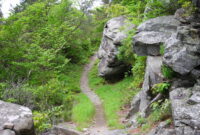Best maps for hiking are crucial for a safe and enjoyable outdoor experience. Choosing the right map, whether paper or digital, significantly impacts your navigation and overall hiking success. This guide explores various map types, essential features, and popular apps, empowering you to confidently plan and execute your next adventure.
From understanding contour lines and elevation profiles to utilizing GPS coordinates effectively, we’ll delve into the practical aspects of map reading and navigation. We’ll also compare different mapping technologies, helping you select the best tools for your specific needs and hiking style, ensuring you’re prepared for any terrain or weather condition.
Illustrative Examples of Map Usage
Maps are essential tools for safe and efficient hiking, providing crucial information about terrain, elevation, and location. Understanding how to interpret map features is vital for planning a successful and safe journey, especially in challenging conditions.
Challenging Hiking Scenario: Navigation and Decision-Making
Imagine a challenging hike up Mount Whitney, California, during an unexpected afternoon thunderstorm. The weather forecast predicted clear skies, but now heavy rain and low visibility have reduced trail visibility. The hiker, equipped with a topographic map, compass, and altimeter, realizes they are off the established trail and facing a steep, rocky slope with limited visibility. The map reveals a safer, albeit longer, route descending to a lower elevation, where the weather is less severe and the terrain more manageable. By carefully consulting the contour lines on the map, identifying their current location using the compass and altimeter, and assessing the relative difficulty of the various routes, the hiker decides to abandon their initial ascent and follow the safer, alternative route shown on the map, prioritizing safety over speed. This decision, informed by the map, ensures their safe return to a more favorable location. The experience highlights the crucial role of maps in adapting to unforeseen circumstances during challenging hikes.
Hypothetical Hiking Route: Map Interpretation and Planning
Let’s consider a planned hike through a section of the Appalachian Trail. The chosen route starts at a trailhead marked with a prominent red blaze on the map at an elevation of 1000 feet. The map shows a gradual ascent for the first mile, indicated by closely spaced contour lines, indicating a steady climb. After this initial climb, the trail follows a ridge line, with contour lines running parallel to the trail, indicating a relatively flat section. The map shows a stream crossing after 2.5 miles, marked by a blue symbol. This water source is vital for replenishing water supplies. After the stream crossing, the trail begins a steeper descent, shown by more widely spaced contour lines, leading to a valley floor at 800 feet. The map further indicates a trail intersection at the 3.5-mile mark, where the hiker can choose to continue on the main trail or take a shorter loop back to the trailhead. Careful examination of the trail markers, symbols, and contour lines allows for accurate planning of the hiking duration, water stops, and overall route strategy.
Map Section: Visual Description
Imagine a section of the map depicting a crucial part of the trail. A prominent “X” marks a trail intersection, where a main trail continues straight ahead and a side trail branches off to the right. A small blue squiggly line indicates a stream located approximately 0.2 miles from the intersection, near the side trail. North is indicated by a directional arrow at the top of the map section. Contour lines are tightly packed together on the western side of the map section, illustrating a steep incline. The elevation changes are indicated by the numbers adjacent to the contour lines, with a difference of approximately 200 feet over a distance of 0.5 miles. The main trail is clearly marked with a solid black line, while the side trail is represented by a thinner, dashed black line. The map’s scale and legend are clear, enabling precise distance and elevation calculations.
End of Discussion
Ultimately, selecting the best map for hiking hinges on understanding your specific needs and the characteristics of your planned route. By carefully considering map type, features, and application, you can significantly enhance your safety and enjoyment on the trail. Whether you prefer the tactile feel of a paper map or the convenience of a digital app, the key lies in mastering map reading skills and using the chosen tool effectively to plan and navigate your hike with confidence.




